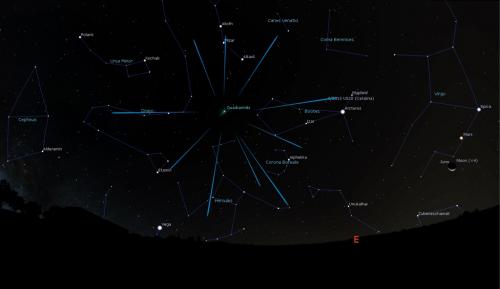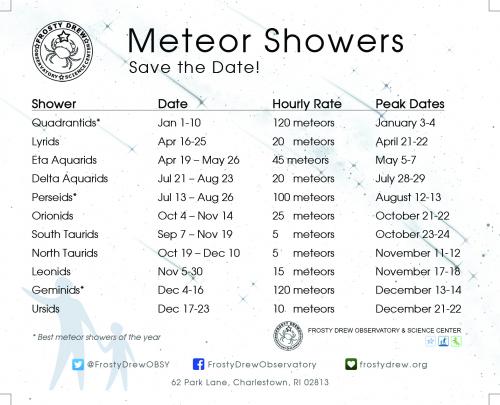Celebration of Space - January 3, 2020
Even though clouds and rain will wreak havoc on most of the eastern US’s plans to observe the annual Quadrantid Meteor Shower peak, anybody with clear skies can rock the shower! The Quadrantids are a product of a potential fragment of the shattered comet 2003/EH1, which is currently listed as an asteroid. As Earth orbits the Sun, we pass through the debris field left by 2003/EH1 in a perpendicular fashion. This causes a very brief peak period when compared to other similar meteor showers. The Quadrantid peak usually lasts for about 3-6 hours and can happen during daylight times. This year, predictions are placing the peak start time at 3:20 am EST. At that time, the radiant point of the meteor shower, the defunct constellation Quadrans Muralis, will be over 40° above the horizon, which is excellent for meteor watchers. Additionally, the 70% waxing gibbous Moon will set at 12:49 am, placing the peak period well after the Moon sets. All of this makes for near perfect conditions to observe a meteor shower peak, that is if you’re outside of the cloud blanket covering most of the US. Regardless, if you find yourself under clear skies tomorrow morning, head out to a dark location, free of light pollution, and be there for 3:20 am EST. Lay on your back with your feet to the NE and look to the zenith (top of the sky) to catch up-to 100 shooting stars per hour streak the sky until the Sun rises. Good luck!
This coming Sunday, January 5, 2020 at 2:47 am EST, Earth will reach the point in our orbit where we are at our closest point to the Sun. This is called perihelion and happens because of the eccentricity (deviation from perfect circle) in Earth’s orbit. At that time, Earth will be 91,398,199 miles distant from the Sun. It’s interesting to some that our closest point to the Sun happens in during the Northern Hemisphere winter season, when it’s the coldest for us in the North. Though our seasons are not a result of our eccentric orbit, but rather our axial tilt, which is 23.4° inclined to the plane of the Solar System. Since we just passed the Winter Solstice (December 21, 2019), Earth is tilted just under 23.4° away from the Sun in the Northern Hemisphere, which places the Sun at nearly its lowest in the sky at noon for the year. Regardless, step outside this Sunday at noon (or sunrise) and welcome the Sun as we make our closest approach for the year.
Now that a new year is upon us, so are a slew of fabulous celestial events. For starters, grab the Frosty Drew Observatory 2020 Meteor Showers Pin-up. This little print out will list all notable meteor showers, with dates, and expected hourly rates, for the 2020 year. Print it, stick it on your fridge, and never miss another meteor shower. Grab the pin-up here:
All of us at Frosty Drew Observatory and Science Center extend our thanks to all who donated to us in 2019, either online or on site! You are all fantastic people and we are thrilled to receive your support. Additionally, here’s a special shout out to the person who ordered the heated dew shield for our 10” SCT telescope that was listed on our Amazon Wish List. It was a special surprise having this arrive in the mail! As we kick off our 2020 year of stargazing and celestial awesomeness, we are thinking about all of you. Thank you and we hope to see you all out at the observatory this year!
-Scott
- Author:
- Scott MacNeill
- Entry Date:
- Jan 3, 2020
- Published Under:
- Scott MacNeill's Columns




